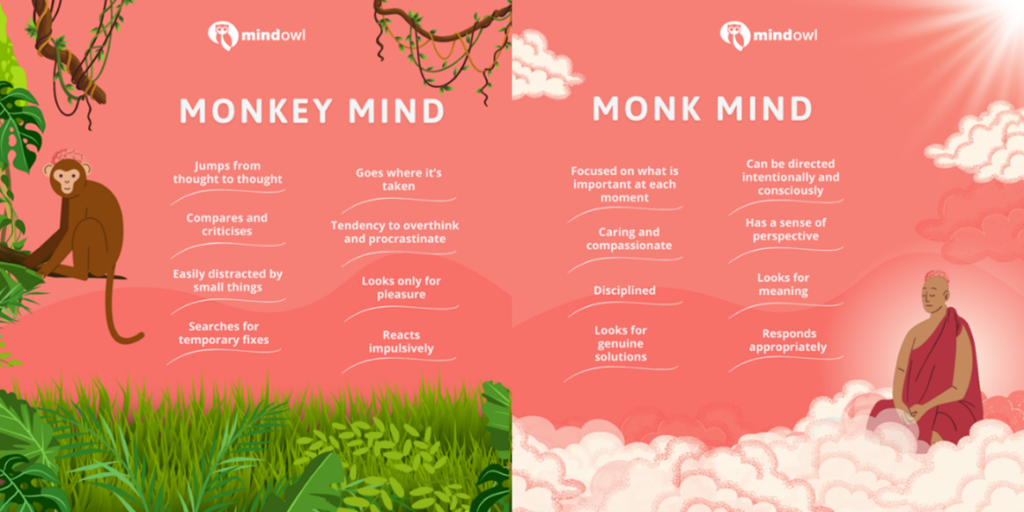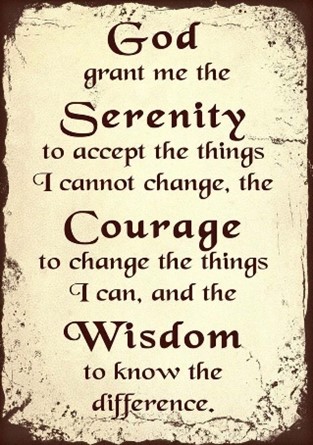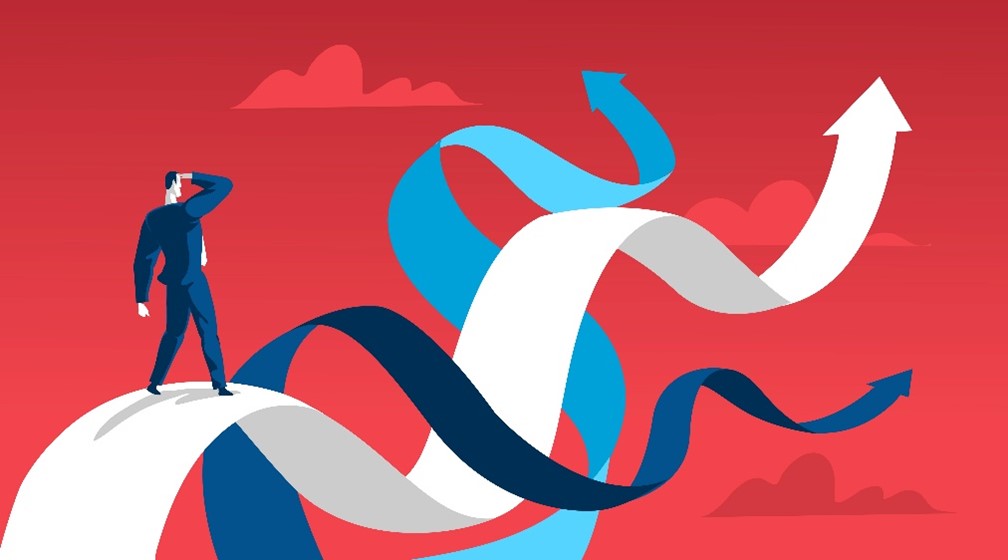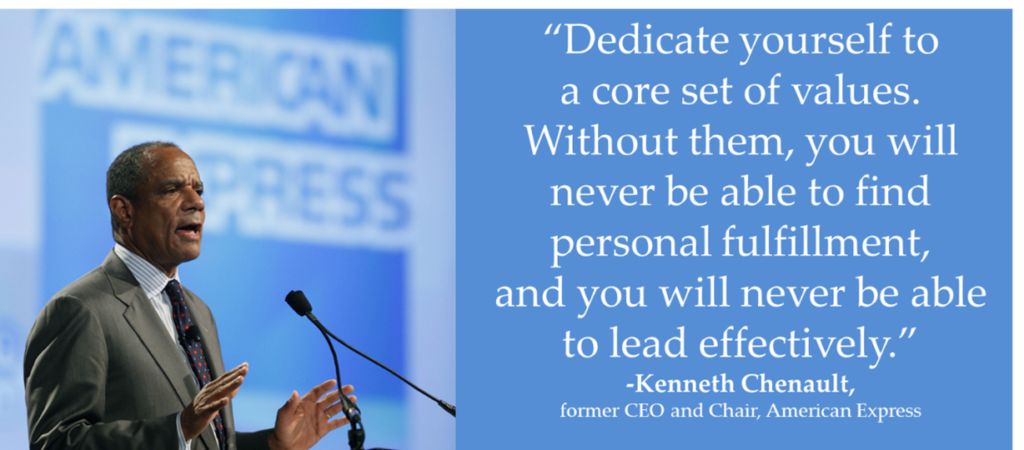Many of us are going through much of our lives with a “monkey mind” that’s restless and easily distracted, with thoughts swinging wildly in different directions. (1) The problem is that chaos in our minds will bring chaos in our life, work, and leadership. It will make us anxious and make it harder for us to accomplish our goals.
Unfortunately, this monkey mind phenomenon is as common as it is old (the term having been coined by the Buddha), and it’s aggravated by the way we tend to work in our modern world.
“I am burdened with what the Buddhists call the monkey mind. The thoughts that swing from limb to limb, stopping only to scratch themselves, spit, and howl. My mind swings wildly through time, touching on dozens of ideas a minute, unharnessed and undisciplined.” -Elizabeth Gilbert, writer
Signs of Our Monkey Mind Going Wild
How to know if we’re afflicted by a monkey mind? When our monkey mind is active, we:
- have scattered thoughts
- feel anxious, restless, and unsettled
- find our mind wandering after just a short while of doing something
- experience mental fatigue
- feel impatient often
- are often bouncing from thought to thought and task to task
- have a hard time focusing on the present moment
- spend a lot of time thinking about the past or the future
- return to the same thought loops over and over again (rumination)
Our monkey mind is a bit like Curious George—always causing trouble. How much of our day do we spend worrying, complaining, or relitigating past sleights? How about assuming the worst and running worst-case scenarios through our minds again and again? These are telltale signs of the monkey mind in action.
“Give anything to silence those voices ringing in your head.”
-from the song, “Learn to Be Still,” written by Don Henley and Stan Lynch, recorded by The Eagles
The Problem with Our Monkey Mind
Though it’s common, monkey mind isn’t harmless. Its restless bouncing from thought to thought comes with many problems, including:
- making us anxious and restless
- amping up our stress levels
- impeding our ability to focus and concentrate
- inhibiting mental clarity
- preventing us from being in the moment, present with people, or focused on the task at hand
- pushing others away if they find it draining or chaotic
- reducing our sense of calm and wellbeing
- disrupting our sleep
- pulling us away from the things that matter most
- reducing our contentment and happiness
- becoming a lifelong habit that harms our mental health, quality of life, and career
Monkey mind is related to what psychologist Mihalyi Csikszentmihalyi, in his book Flow, called “psychic entropy,” a condition of inner disorder that impairs our control over our attention and our effectiveness. With psychic entropy, a negative feedback loop can form in which we feel unpleasant emotions that make it hard for us to focus, thus causing us to fail in achieving our goals, then starting the cycle all over again—and sapping our confidence. He wrote, “Prolonged experiences of this kind can weaken the self to the point that it is no longer able to invest attention and pursue its goals.”
How Our Monkey Mind Inhibits Our Leadership
A monkey mind can also haunt leaders and managers. Think of Karen, a busy executive facing a steady stream of challenges in her work. At breakfast, she’s preoccupied with the presentation she will give to an important customer later, and she’s running late. She’s also worried about her son’s new friends. In her two morning meetings, she’s thinking about what to do with Jerry, a longtime colleague who’s been struggling with an important new project, and how to approach the upcoming board meeting.
When she calls her husband over lunch, she remembers that she forgot to schedule her car for service. In her customer meeting, she nails the delivery but then spirals into self-doubt when the conversation turns to future product releases, and she relives a heated exchange she had with the IT team this week.
At the gym after work, she’s revisiting her answers to the customer’s questions about functionality, and at dinner with her family she’s wondering again about what to do with Jerry. In bed that night, she’s reading a novel, but her mind keeps drifting to the problems of the day, so she must go back and re-read almost every other page. When the lights are out, her head keeps spinning.
“If you just sit and observe, you will see how restless your mind is. If you try to calm it, it only makes it worse, but over time it does calm, and when it does, there’s room to hear more subtle things—that’s when your intuition starts to blossom and you start to see things more clearly and be in the present more. Your mind just slows down, and you see a tremendous expanse in the moment. You see so much more than you could see before. It’s a discipline; you have to practice it.”
-Steve Jobs
Monkey mind inhibits our leadership by:
- leading us to poor, impulsive decisions or slowing down our decision-making
- making us more reactive than proactive
- harming our credibility
- preventing us from focusing on our priorities
- reducing our executive presence
- preventing us from listening well to others
- frustrating our colleagues
- killing our enjoyment of our free time
- increasing our stress and anxiety
- harming our sleep
Monkey mind relates to many of the leadership derailers that inhibit our leadership effectiveness, potentially including avoiding tough issues, being a bottleneck on big decisions, causing chaos for the team, not being sufficiently clear, becoming ego-centric, being hyper-critical, impulsive, indecisive, or insecure, not listening well, being obsessive or perfectionistic, being pessimistic or prone to overreaction, and becoming a workaholic.
What to Do About It
We’ve seen how our monkey mind can detract from our work, leadership, and quality of life. So, what to do about it? Here’s a punch list of things we can do to start addressing our monkey mind:
Think of our monkey mind as something to befriend as opposed to an enemy we need to vanquish. In some ways, it’s built into our brain’s design. Calm redirection will serve us much better than judgment and resentment. According to Leo Babauta of Zen Habits, “if we create a calm space for the monkey mind to jump around in, it will eventually settle down.” (2)
Meditate. With meditation, we can train our minds to become more present, focused, and still. We can train our attention and awareness, helping us feel calm and clear. Studies have found that meditation can lead to improvements in brain function, blood pressure, metabolism, sleep, focus, concentration, and even our lifespan, as well as alleviation of stress and pain. University of Wisconsin neuroscientist Richard Davidson has conducted experiments on the effects of meditation on the brain. His results suggest that meditation may lead to change in the physical structure of the brain regions associated with attention, fear, anger, compassion, anxiety, and depression. (See the Appendix below for some common types of meditation.)
“Be here now.”
-Ram Dass, Be Here Now
Breathe deeply and do breath work. During breathing practices, we can place our attention on our breath (e.g., we can focus on the top of our head when we breathe in and our diaphragm when we breathe out). This can include deep breathing exercises, such as box breathing in which we breathe in while slowly counting to four, hold our breath for four seconds, slowly exhale for four seconds, and then hold our breath again. (Each of these four steps forms one side of an imaginary box.) Then repeat the process.
“Being aware of your breath forces you into the present moment—the key to all inner transformation.”
-Eckhart Tolle, A New Earth
Engage in mindful, offline activities. When we’re doing something—anything—place our attention on what we’re doing and only that. Focus on the sensations of washing the dishes on our hands or the taste, texture, and smell of the food we’re eating. Meanwhile, we should engage more in real-world offline activities. Read a book. Play a musical instrument. Go for a walk. Watch the squirrels and birds in our backyard. And we should be mindful and present while doing it, bringing our attention back to the moment when it wanders.
Play the “game of fives.” Writer Marelisa Fabrega recommends pausing our thinking and noticing five things in our vicinity that we see, hear, or smell. Then, fully experience them. It may help to pretend that it’s the first time we’ve ever experienced that sight, sound, or smell. When we do this, all our attention moves to the present moment.
Reduce distractions. It seems like the modern world is designed to agitate our monkey mind with a barrage of inputs and distractions, from texts and emails to videos, breaking news alerts, streaming shows, and social media posts. Put our smartphones away (out of sight) and turn off notifications. The key here is breaking our addiction to numbing and distraction, in which our brains are constantly flooded with stimuli designed to capture and control our attention. Along these lines, we should wean ourselves from the habit of taking out our smartphone every time we get bored. That mindless, compulsive behavior only stimulates the monkeys in our mind to race quickly from thought to thought as we keep swiping.
Take breaks in between activities. Grab a cup of coffee. Gaze at the horizon. Get some fresh air and sunshine. Take some deep breaths. Take a nap. Even short breaks are restorative.
“There is more to life than increasing its speed.”
-Mahatma Gandhi
Journal. Jotting down our thoughts and feelings in a diary or journal can be beneficial because it allows us to express our emotions freely, clear out distressing thoughts, organize our thoughts, gain new insights, recover a sense of control, find patterns, and deepen our understanding of the events in our lives (and ourselves). According to research studies, journaling can help with anxiety, hostility, and depression. It’s been linked to measurable effects on our health and immune system response. Tip: For best results, include both thoughts and feelings when journaling (and avoid rehashing troubling thoughts over and over), and consider adding some drawing or doodling to the text as well. (See my article, “Journaling: Benefits and Best Practices.”)
Practice self-care. Engage in regular self-care practices, including sleep, exercise, nutrition, and relaxation. Turn these into habits and regular routines. All of these can have calming effects on our minds through various mechanisms that are well documented.
Find sanctuary. Create a space of sanctuary associated with a calm mind, such as a place to think or write, or a place to meditate or pray. It can be a place of worship, a quiet retreat in the backyard, a trail in the woods, a quiet park nearby, or a peaceful kayaking outing on a lake. For some people, it can simply be a centering practice, and not necessarily a place.
Get out into nature. More than a hundred studies have documented the benefits of being in or living near nature—and even viewing nature in images and videos. According to the research, it can have positive impacts on our thoughts, brains, feelings, bodies, and social interactions—including reduced stress, enhanced recovery from illness, and changes in our behavior that improve our mood and overall wellbeing. Viewing nature can calm our nervous system and lead to a cascade of positive emotions that can in turn promote things like creativity, connection, cooperation, kindness, generosity, and resilience. Experiencing nature can also induce powerful feelings like awe, wonder, and reverence. Unfortunately, many of us today suffer from what environmental writer Richard Louv calls “nature deficit disorder.” (See my article, “The Benefits of Nature and Getting Outside.”)
Do deep work. In his book, Deep Work: Rules for Focused Success in a Distracted World, Georgetown University computer science professor Cal Newport notes that to produce at our peak level we need to be able to do “deep work”—working “for extended periods with full concentration on a single task free from distraction.” Such deep work is now as valuable as it is rare, and it will be a big differentiator for those who develop the capacity to do it well. It requires discipline and weaning our minds from the easy comforts of distraction. “Efforts to deepen your focus will struggle if you don’t simultaneously wean your mind from a dependence on distraction.
Write things down. If our monkey mind is bouncing between several thoughts and worried about missing or forgetting things, the simple act of writing things down can be surprisingly reassuring for many of us.
Use a shutdown ritual at the end of each workday. Newport also recommends implementing a strict shutdown ritual at the end of our workday. For every incomplete task, goal, or project we face, we should either have a plan for its completion or capture it in a place where we can revisit it later. That way, we’ll know “it’s safe to release work-related thoughts for the rest of the day.”
Engage in activities that put us in a state of “flow.” Professor Mihalyi Csikszentmihalyi characterized flow as a state of complete absorption, almost effortless attention, and peak performance. In flow, he writes, we invest our attention fully in the task at hand, and we function at our greatest capacity. When in a flow state, we’re so engaged in what we’re doing that we stop thinking about ourselves as separate from the activity. We’re so absorbed in it that time seems to slow down or stop for us. How to experience flow more often? We need three things:
- a clear set of goals
- clear and immediate feedback so we can tell if we’re advancing toward our goals
- the right balance between the challenges we face and our skills (if there’s too little challenge, we’ll get bored, and if there’s too much challenge, we’ll feel anxiety)
Serve others. The monkey mind tends to be ego-centric, focusing mostly on ourselves. We can disrupt that narcissistic loop by focusing instead on serving others—and being present in the act of contributing.
Find and embrace things worthy of our focus. Too often, our monkey mind is ruminating about things of little significance. We should be disciplined in dedicating more of our lives to things that matter—to things that honor our purpose and core values and allow us to contribute to others and make an impact—with consistent routines.
“If you want to win the war for attention, don’t try to say ‘no’ to the trivial distractions you find on the information smorgasbord; try to say ‘yes’ to the subject that arouses a terrifying longing, and let the terrifying longing crowd out everything else.” -David Brooks, “The Art of Focus“
Conclusion
We’ve seen that the monkey mind can cause great suffering in our lives and be a real disruptor in our work. And we’ve covered many ways to address it.
The result should be a mental disposition that more often than not is the opposite of monkey mind—one of tranquility and inner peace. A disposition of acceptance (or “nonresistance” as the Buddhists call it) and of equanimity and ease.
Filipe Bastos from MindOwl makes a distinction between monkey mind and “monk mind,” which entails presence, focus, compassion, discipline, perspective, and consciousness. See the image below.

The good news is that our brains have an amazing capability to rewire their neural pathways. With neuroplasticity, our brain’s neural networks can change through growth and reorganization. As a result, investments in our focus, attention, and consciousness can pay real dividends over time if we commit to daily practice over time.
Science writer Winifred Gallagher notes that the findings from many disciplines “suggest that the skillful management of attention is the sine qua non of the good life and the key to improving virtually every aspect of your experience…. Who you are, what you think, feel, and do, what you love—is the sum of what you focus on…. I’ll live the focused life, because it’s the best kind there is.”
Here’s to a life in which we can focus attention on things that are worthy of it, thus lifting us up.
Reflection Questions
- Are you struggling with the chaos and disruption of a monkey mind, with thoughts swinging wildly in different directions, causing distraction and anxiety?
- How is it affecting your quality and enjoyment of life and work—and your productivity and performance?
- What will you do about it, starting today?
Tools for You
- Traps Test (Common Traps of Living) to help you identify what’s getting in the way of your happiness and quality of life
- Quality of Life Assessment to help you discover your strongest areas and the areas that need work and then act accordingly
- Personal Values Exercise to help you clarify what’s most important to you
Related Articles
- 17 Signs Your Monkey Mind Is Running Wild
- Designing Your Work for Flow
- The Mental Prisons We Build for Ourselves
- How to Stop Catastrophizing—Managing Our Minds
- Journaling: Benefits and Best Practices
- Breaking the ‘Trance of Unworthiness’
- The Benefits of Nature and Getting Outside
Related Books
- Shirzad Chamine, Positive Intelligence: Why Only 20% of Teams and Individuals Achieve Their True Potential
- Cal Newport, Deep Work: Rules for Focused Success in a Distracted World
- Eckhart Tolle, The Power of Now: A Guide to Spiritual Enlightenment
- Thibaut Meurisse, Master Your Emotions: A Practical Guide to Overcome Negativity and Better Manage Your Feelings
Postscript: Inspirations on Calming Our Monkey Mind
- “Nothing can harm you as much as your own thoughts unguarded.” -Siddhartha Gautama (the Buddha)
- “The mind is its own place, and in itself can make a heaven of hell, a hell of heaven.” -John Milton, Paradise Lost
- “What your future holds for you depends on your state of consciousness now.” -Eckhart Tolle, A New Earth
- “Learn to watch your drama unfold while at the same time knowing you are more than your drama.” -Ram Dass
- “When you are tempted to control your mind, stand back and realize that the task is impossible to begin with. Even the most disciplined mind has a way of breaking out of its chains.” -Deepak Chopra, spiritual teacher and author
- “As you walk and eat and travel, be where you are. Otherwise you will miss most of your life.” -Jack Kornfield, author
- “Many people are so completely identified with the voice in the head—the incessant stream of involuntary and compulsive thinking and the emotions that accompany it—that we may describe them as being possessed by their mind…. The greater part of most people’s thinking is involuntary automatic, and repetitive. It is no more than a kind of mental static and fulfills no real purpose. Strictly speaking, you don’t think: Thinking happens to you…. The voice in the head has a life of its own. Most people are at the mercy of that voice.” -Eckhart Tolle, A New Earth
Appendix: Some Common Type of Meditation Practice
- Body scan meditation, in which we direct our attention to sensations happening in our body. We can mentally scan over every part of our body, from head to toe.
- Focused attention meditation, in which we focus on one thing, such as our breath, and when our mind wanders to other thoughts, we gently bring our attention back to our breath.
- Loving kindness meditation (also known as metta meditation), in which we silently repeat in our mind phrases of benevolence or good wishes directed at ourselves, people we love, neutral people, rivals, animals, and/or the world or universe.
- Mindfulness meditation (also known as open monitoring meditation), in which we observe our thoughts nonjudgmentally without reacting to them, acknowledge them, and then let them go. It can also include deep breathing and bringing our attention to our mind and body. (3)
- Transcendental meditation, in which we use a silent mantra repeated in our mind for 15 to 20 minutes twice a day, with an eventual aim of experiencing what they call “pure awareness” or “transcendental being.”
(1) The term “monkey mind” is attributed to the Buddha, and there are later uses of “mind monkey” expressions from the Later Qin dynasty in China. Side note: Apes are the ones that usually swing through the trees, while monkeys more often run on tree branches rather than swing.
(2) Source for this tip: Leo Babauta, “Monkey Mind: Shifting the Habit of Feeling Distracted Throughout the Day,” ZenHabits.net, undated.
(3) The default mode network includes regions of our brain that are active when our brains are idling (i.e., not focused on a specific task) and moving from thought to thought by default. According to researchers, mindfulness meditation can deactivate the regions of the brain associated with this network, perhaps even changing the structure of the brain over time, allowing us to switch off this network more and more.
++++++++++++++++++++++++++++++
Gregg Vanourek is a writer, teacher, & TEDx speaker on personal development and leadership. He is co-author of three books, including LIFE Entrepreneurs: Ordinary People Creating Extraordinary Lives (a manifesto for living with purpose and passion) and Triple Crown Leadership: Building Excellent, Ethical, and Enduring Organizations (a winner of the International Book Awards). Check out his Best Articles or get his monthly newsletter. If you found value in this article, please forward it to a friend. Every little bit helps!






















